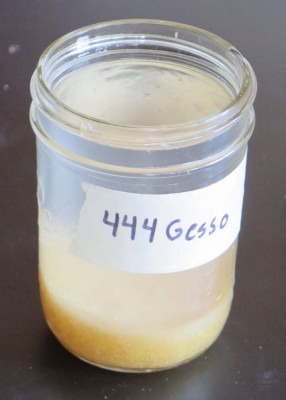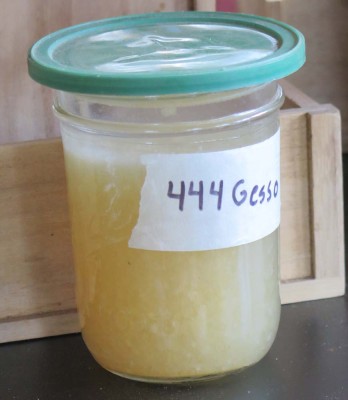One Implication of Hide Glue “Gram Weight Strength”
So there I was, mixing up a new batch of traditional gesso to use as the ground (primer) on some japanning samples I was preparing for an upcoming video shoot at Popular Woodworking. The first step is always the soaking of the glue in order to cook it twice before adding the calcium carbonate (a/k/a whiting or pulverized chalk) to the mix to create the ground.

I was using 444 gram weight strength (gws) glue for the mix because I could not put my hands on my jar of 512 gws granules. My working process has always been to put dry gue granules into the bottom of a jar filling approximately 1/10th of the height, then adding water to let it hydrate in preparation for the cooking. I usually let this sit overnight.

As always, within minutes the glue began to swell as it adsorbed water into the dry protein coils, and expand until it was fully hydrated after a few hours. This visual reminder in turn caused me to reflect on an important truth about hide glue and how we use it.
Now, the relative tensile strength of glue is a fairly linear function of its gram strength fraction, so logic would lead us to conclude that the highest number of glue fraction would yield the highest bond strength. (Tensile strength, the ability for a material to resist being pulled apart, and shear strength, the ability of a glue line to keep two adherends together while they are being puled apart parallel to the glue line, are fundamental factors in glue performance.)
Higher gram weight strength glues result in the best performance, right? After all they have the higher tensile and shear strength.
Not so fast!
The water uptake for total hydration is also a linear function and I could show you the data I derived in my testing, but my lab notebook for glues and their manipulation is somewhere in the remaining boxes of books awaiting unpacking. But the point is this: the higher the number of the glue grade/fraction, the more water is required for complete hydration. Coincidentally, my testing confirmed that the viscosity of all grades is the same at total hydration, but the amount of water uptake for total hydration can vary dramatically as the longer protein chains of the higher grades need a lot more water.
In other words a low number glue and a high number glue can have the same hydration ad viscosity despite the fact that the solids content percentage for the higher number is only a fraction of the solids content percentage of the lower grade.
What does this mean? Well, for on thing the higher glue grades require a lot more water to achieve the same working properties of the lower grades (there are many other considerations, but this is an important one). And, all the water that goes into the hide glue system has to come out in order for the glue to achieve its maximum performance.
Seriously, what does this mean?
What it means is that the “stronger” higher gram strength glue may not yield the strongest glue line. Since a higher glue grade has to take on more water to be used, it will in turn lose that water in curing, and that water loss is accompanied by shrinkage of the glue mass, or, more likely, the in-building of internal stresses (sometimes breathtakingly huge) into a glue line, setting the stage for glue line fracture and eventual failure in the future.
I used to use 315 gws glue a lot, sometimes even 379 gws. However after some simple testing my strategy has changed pretty dramatically such that I now use 192 gws glue (or even lower) for most of my routine joinery applications and leave the higher gram weight strength glue for other applications.



Join the Conversation!